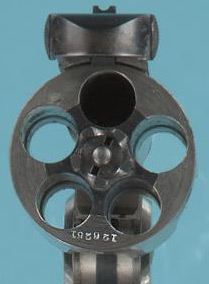- 01: Introduction
- 02: History
- 03: Propellants, Firearms, and Ammunition Development
- 04: Modern Firearms Manufacture
- 05: Small Arms Ammunition
- 06: Evidence Handling Procedures
- 07: Equipment and Instrumentation
- 08: Examination of Firearms
- 09: Cartridge and Shotshell Examination
- 10: Characterization and Evaluation of Fired Projectiles
- 11: Bullet Comparison and Identification
- 12: Gunshot Residue and Distance Determination
- 13: Toolmark Identification
- 14: Communicating Results
- Resources


Cylinders
Home > Modern Firearms Manufacture > Parts Fabrication > High Stress Load Parts > Cylinders
Revolver cylinder manufacture requires attention to three areas:
- Providing strength well in excess of that needed to contain the firing pressure of a standard cartridge
- Insuring that all chambers are precisely the same angular distance apart to consistently deliver the bullet into the barrel
- Insuring that indexing surfaces (those controlling rotation) are precise and durable

Revolver cylinder
The first issue is handled largely with metallurgy and engineering. Strong alloys are used for powerful handguns. Some of the most powerful revolvers use special steels not normally found in small arms cylinders. Regardless of alloy, the cylinder begins as a forged bar made at the arms factory or specialty cylindrical stock. The latter can be ordered to precise size requirements, decreasing the amount of work in reducing the cylinder blank to final diameter and length. The other factors are dimensional including the distance between cylinders and the thickness of metal around each chamber. The designer must match these dimensions to the capabilities of the selected steel alloy.
Cylinder indexing and its effect on accuracy has always been a problem for revolver manufacturers. Until the last two decades, most indexing equipment that controlled the angular distance between chambers was accurate to only +/- 1 percent. This causes an increase in hand fitting required at assembly on a gun-to-gun basis. Today, modern computer-controlled drilling equipment has improved angular accuracy by at least an order of magnitude.




